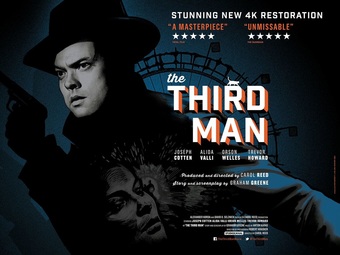
(As this is a film from the past, this movie has some spoilers).
“They sure don’t make them like they used to,” is probably what you here from generations before us (or hipsters, now). Sure enough, if you look at the industry now, you’ll lament that the oversaturated market has led to sequels, reboots and remakes that all repeated the same incredibly dull story. See, at this point, we’ve seen it all and we can easily harken back the good old days that was filled with ingenuity; lauding up each film as a riotous success and negating the issues of yesteryear that we have apparently moved on from (for example, racism, misogyny and more are still rife in some films today).
Anyway, I’m digressing.
The point is that there are faults trickling throughout the industry and it seems very pithy to abhor one era whilst negating the issues of another. But let me tell you this, the minute you walk away from Carol Reed’s The Third Man, you cannot help but whisper underneath your breath “damn, they sure don’t make them like they used to.”

Carol Reed, more famed and awarded for his work on musical Olivier!, reinvents directing with his acclaimed work, once voted the Best British Film. The movie is a sublime example on how camera angles and different shots could mount the tension slowly and evocatively. Each frame is pivotal to telling the story, with the right level of noir shadows casting aspersions on our characters. He is able to wield the action and balance the emotions. Reed arches the story through these sublime scenes such as the tunnel finale or Lime looming on top of a disarray of buildings, making in exquisite to watch - especially in this recent 4k restoration. Tantalising the streets of Vienna with the post-war paranoia and criminal underbelly, Reed establishes the atmosphere effectively and continues to disentangle the mystery through aid of an unravelling story.
After all, the theme that walks along the cobbles and climbs over the rubble is that of despondency and a lack of humanity. Teaming with this desolation, both within the sets and script, The Third Man is the aftermath of war and how exploited this fragile essence of humanity is by the scoundrel Harry Lime. As Martins unearths his friends secrets, he realises that the biggest darkness that encompasses Vienna is not the shell of the cities or the political states invested there, it’s the men who prey on desperation just to earn a quick buck or too. This all makes Lime such a sinister player within the film, enhancing on that theme of the film: When all the unity has dissolved post-war, as moving on and sweeping up become key, vultures will swoop in.

Because that’s when Lime emerges from his supposed death - very much alive and well. Anyone can tell that, regardless of his short screen time comparatively to the others, this is really Orson Welles’ film. Harry’s reappearance adds this ominous layer to the film that is entrancing. From Lime’s smirk to Martins, to his enthralling villainous monologue in a fairground, this is a stunning performance. (By the way, the juxtaposition between divulging his murderous inclinations against the innocent backdrop of a funfair, reminiscent of the victims to his plot, is magnificent). Welles does not have to utter much to control the screen. His presence is sure, developed and masterful. As he loom over Martins, he casts a long terrifying shadow across the audience, attracting us to his heinous ways whilst we condemn them too.
Look no further than Harry Lime’s (and Orson Welles’) introduction to marvel at how tremendous this film is. Solidifying all these remarkable points - the direction, the story, the acting and the cinematography - the entrance of Lime is so unforgettable that you can’t help but re-watch. As Martins walks in the dark night, he is followed by a cat who then takes a shine to a figure in the black of a doorway. When he shouts at the man, telling him to come out from hiding, he disturbs a woman whose bedroom light illuminates the step, showing the figure to be Lime all along. It’s indicative of Welles’ dominance and talent on screen that he is able to convey so much with no words. The smirk and knowing eyes that dart to Holly as the camera cuts between the pair is a heart-racing mid-movie twist.
Here’s the clip, courtesy of Studiocanal, showcasing exactly how noir thrillers are done.
Damn, they just don’t make them like this anymore.

 RSS Feed
RSS Feed
